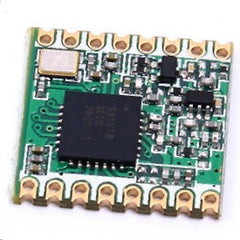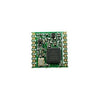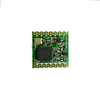RFM95W / RFM96W Radio
- Vendor: HopeRF
- Type: Components
LoRa™ is here! The innovative RFM95W / RFM96W radio transceiver modules by HopeRF build on the strengths of the RFM69 series by adding support for the LoRa™ PHY modulation method. This spread-spectrum technique can communicate even when signals are buried in the background noise, providing long range, with high interference immunity at an adequate bit error rate. Typically there is no need to blast out at the full +20dBm transmit power available, minimising current consumption, even for extended range, line-of-sight applications.
Great for sub-compact designs; just 4mm of mounted height from using an SMD style precision crystal and the familiar castellated edge pins (N.B. 16pin not 14pin packaging)
Though consuming a similar level of power, the receiver section can decode fainter signals than the classic RFM12B or in LoRa mode, the RFM69 series. The transmitter section maximum output power is +20dBm, considerably higher than the +5dBm of the RFM12B. The current drain at these (adjustable) higher power settings is correspondingly higher. With the better receiver sensitivity, many applications will not need to use the higher transmit power settings, potentially saving on battery life.
Comparing like-with-like, pairs of modules will generally have greater range and/or better penetration of walls/ceiling than when using pairs of the classic RFM12B or RFM69 series. Extended range is achieved at lower baud rates, so the 'on air' time is greater than the standard library high speed settings.
The physical module footprint is not compatible with the PCB footprint on classic JeeNodes and JeeLinks. The recommended power supply range of 2.2 < Vdd < 3.7 V can squeeze almost the last energy out of depleting batteries (e.g. 2x AA) without needing a boost converter.
N.B.: An antenna must be connected to the module. A quarter wavelength wire – 82mm for 868 MHz, 165mm for 433 MHz – works fine (solder the correct length wire included with Duo packs). Caution: operation for extended periods without an antenna at the higher transmitter power levels risks permanent damage to the module output stages.
Ordering Options:
Match your local requirements by selecting the correct ISM band with the 868 MHz RFM95W Single or the 434 MHz RFM96W Single.
The 868 MHz RFM95W Duo or the 434 MHz RFM96W Duo conveniently have a pair of band-matched radio modules for experimenting with LoRa™ PHY.
All variants come with pre-cut antenna wires, for soldering to the RF module.
Discounted 6Pack options are available - email us for pricing.
Typically the 868 MHz ISM band has better penetration of light obstacles such as plaster walls and ceilings plus this band is often less crowded. Theoretically, line of sight propagation is further at 434 MHz but practical results show similar Km ranges with appropriate speed/spreading factor settings and careful carrier frequency adjustment.
For testing, these modules will work in the 'wrong band', but reliably only at bench top separation since the antenna matching circuit is then forced well outside of its intended operating range.
Marking Convention: a yellow spot on the top of the transceiver chip indicates optimised for the 868 MHz ISM band, a green spot for 433 MHz.
For detailed specifications, see HopeRF’s RFM95W documentation.


